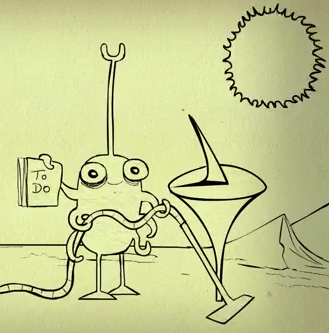1/3 the distance from the Sun than Earth, it should be no surprise that a day on Mercury is a real scorcher with temperatures soaring over 400 ºC. But in addition to its solar proximity it also has an extremely slow rotation: a single day on Mercury is 58.6 Earth days long… and you thought your Mondays lasted forever!
To be even more precise, for every 2 Mercury years, 3 Mercury days pass — a 3:2 spin-orbit resonance, caused by the planet’s varying elliptical orbit. (This also makes for some interesting motions of the Sun in Mercury’s sky.)
To illustrate this, UK’s The Open University has published a new video in their 60 Second Adventures in Astronomy series… check it out above (and see more of their excellent and amusing animations here.)
Video: The Open University. Narrated by David Mitchell.


Too much cute aliens, not enough explaining. The orbit would still make the sun rise or set before or after the spin of the planet made it happen.
And “Mercury is a scorcher” annoys me. It hardly has an atmosphere to be hot.
Rather than “1/3 closer to the Sun than Earth”, I think I’d’ve said “1/3 the distance to the Sun” instead
It should probably be “1/3 the distance from the Sun,” come to think of it.
So how fast would you have to travel on Mercury to see the Sun in the same position in the ‘sky’? (I realize that no atmosphere means no sky.) Once around every 58.6×2 days? That’s only about 4700 miles, at 60 degrees latitude, in about 106 days which would be about 1.7 miles per hour. A slow walk. – My real question relates to maintaining a constant, comfortable temperature between, say, 0 and 100 C. Which would mean …
58.6×3. The rotation time is not the same as the length of day, of course. The earth spins 366 times per revolution, but “loses” a day by going around the sun. Mercury spins three times in two years, and “loses” two days–so the length of each day is two years long.
As for realism, as close as Mercury is to the sun, I find it unlikely that the apparent size of the sun above Mercury in that animation is anywhere near accurate.
See this for an idea of the size of the Sun in Mercury’s sky: http://messenger-education.org/Interactives/ANIMATIONS/Places_In_Sun/places_in_sun.php
If mercury has a day of 58.6 Earth days it would have over six days in one year.